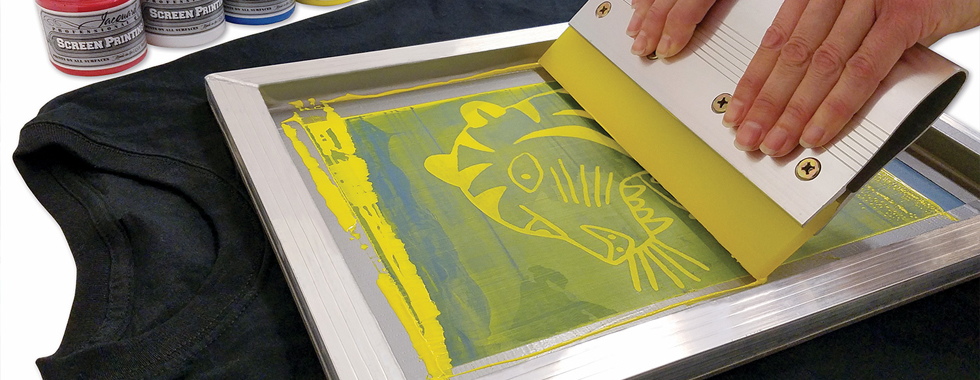ChatGPT said: How 10:9 Design Screen Printing can elevate your team spirit
Wiki Article
The Necessary Guide to Recognizing Screen Printing and Its Versatile Utilizes
Screen printing has an abundant history that goes back to ancient times, advancing into an innovative method made use of across numerous markets today. This overview checks out the complexities of the screen printing procedure, detailing its applications in home, fashion, and advertising style - 10:9 Design contact. Comprehending these fundamentals can open up imaginative potential for both industrial and imaginative projects. The adhering to sections will disclose necessary suggestions and strategies to enhance one's screen printing undertakingsThe History of Screen Printing
Although screen printing has origins that map back centuries, its evolution shows the artistic and technical innovations of different societies. Coming from ancient China, the method was originally made use of for enhancing fabrics and later infect Japan, where it ended up being important to Ukiyo-e woodblock printing. The technique shifted to Europe in the 18th century, where it gained appeal amongst artisans and commercial printers. The invention of photo solution in the 20th century changed screen printing, permitting for even more complex styles and greater efficiency. Musicians like Andy Warhol even more thrust its appeal, utilizing the medium to create iconic jobs that blended commercialism and art. By the late 20th century, screen printing had established itself as a functional technique, used in vogue, advertising, and great art. Today, it remains to advance, integrating digital innovation and expanding its applications throughout various sectors.The Screen Printing Process Explained
Screen printing changes creative visions right into substantial designs via a series of specific steps. A photo is developed and after that transferred onto a screen, commonly made of great mesh fabric extended over a frame. A light-sensitive solution is put on the screen, which is revealed to light, hardening in areas not covered by the photo. After washing out the unhardened solution, a pattern is developed.Next off, the screen is placed over the substrate, whether it be textile, paper, or another material. Ink is after that pressed through the open locations of the stencil utilizing a squeegee, depositing the design onto the substrate below. This process can be duplicated for several shades, needing different screens for each and every hue. The published thing is healed making use of warmth to assure the ink sticks effectively, resulting in a sturdy, vivid layout all set for usage.
Sorts Of Screen Printing Techniques

Additionally, specialty techniques, such as discharge screen printing, eliminate color from the material to develop softer prints, while foil screen printing uses metal aluminum foil to attain a glossy coating (10:9 Design Embroidery). Each method supplies distinct features, dealing with various innovative demands and manufacturing scales, eventually increasing the opportunities within the screen printing domain
Applications of Screen Printing in Various Industries

Additionally, the signs and advertising markets make use of screen printing for producing attractive screens and banners. This method enables vibrant colors and elaborate layouts that capture focus. In electronics, screen printing is used for applying conductive inks to motherboard, vital for component links. Additionally, the home style industry accepts screen printing to create distinct layouts on textiles and wall art. Overall, screen printing works as a vital device throughout varied areas, boosting items with individualized and aesthetically enticing graphics.
Tips for Effective Screen Printing Projects
While undertaking a screen printing project, careful attention to detail can significantly boost the last end result. Initially, picking high-quality materials is necessary; this consists of the screen, inks, and substrates. Utilizing suitable mesh counts can affect ink deposition and information resolution. Prep work is just as vital; detailed cleaning of screens and proper direct exposure times assure crisp prints.Next off, precise registration is critical for multi-color prints. Making use of placement devices can aid attain precise layering. Additionally, screening prints on scrap products before manufacturing aids recognize possible issues without squandering sources.
Often Asked Concerns
What Materials Are Ideal for Screen Printing on Material?
Cotton and polyester blends are optimal for screen printing on material due to their durability and ink absorption. In addition, specialized materials like silk or canvas can generate one-of-a-kind structures and finishes, boosting the general design quality.Exactly how Do I Clean and Maintain Screen Printing Equipment?
To keep and clean screen printing tools, one ought to frequently clean screens with ideal solvents, examine mops for wear, lubricate moving components, and store all products in a completely dry, dust-free atmosphere to extend their lifespan.What Are the Environmental Influences of Screen Printing?
Screen printing can have significant ecological influences, including 10:9 Design near me chemical waste from solvents and inks, water use throughout cleansing processes, and energy intake. Sustainable methods and environmentally friendly materials are vital for minimizing these unfavorable impacts.Can Screen Printing Be Done in the house Effectively?
Screen printing can be successfully done at home with the right materials and methods. Enthusiasts can create high quality prints, though success depends upon their ability degree, equipment, and understanding of the process entailed.
What Are the Costs Connected With Beginning a Screen Printing Organization?

Starting a screen printing organization involves costs for devices, products, and work space. First costs commonly vary from a couple of hundred to several thousand dollars, depending upon the scale, top quality of machinery, and desired production ability.
Screen printing has an abundant history that dates back to old times, advancing into a sophisticated technique used throughout different industries today. Another strategy, rotating screen printing, uses round displays, promoting constant printing on material rolls, consequently improving effectiveness for large-scale manufacturings. Additionally, specialized methods, such as discharge screen printing, remove color from the textile to produce softer prints, while foil screen printing applies metal aluminum foil to accomplish a shiny surface. In the style industry, screen printing is extensively utilized to develop dynamic layouts on apparel, allowing brand names to showcase their one-of-a-kind styles. Cotton and polyester blends are excellent for screen printing on material due to their durability and ink absorption.
Report this wiki page